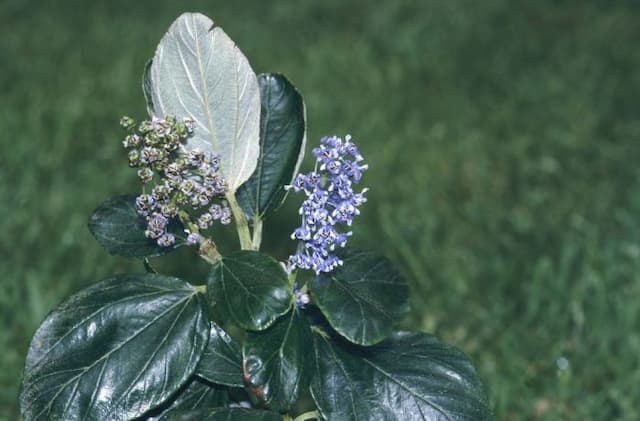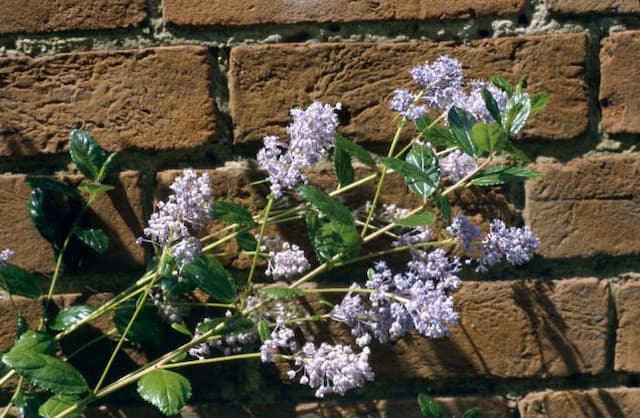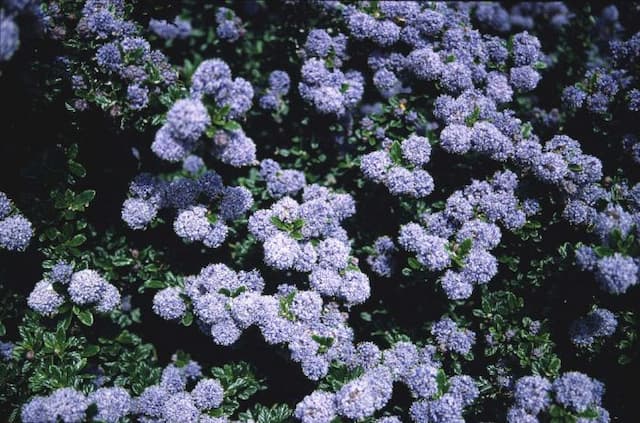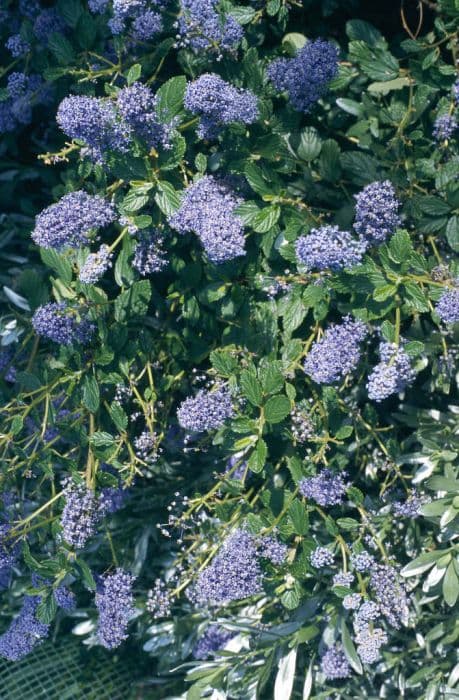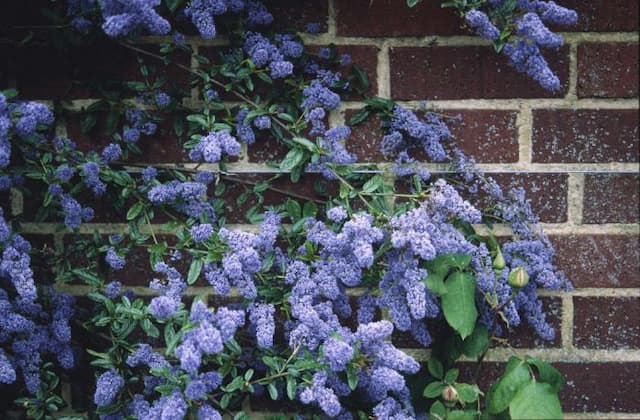Californian lilac 'Cynthia Postan' Ceanothus 'Cynthia Postan'

ABOUT
'Cynthia Postan' is a dense, rounded, evergreen shrub to 2.5m with glossy, dark green leaves and rich blue flowers profusely borne in dense clusters in late spring and early summer
About this plant
 Names
NamesFamily
Rhamnaceae
Synonyms
California Lilac, Blueblossom
Common names
Ceanothus 'Cynthia Postan'.
 Characteristics
CharacteristicsLife cycle
Perennials
Foliage type
Evergreen
Color of leaves
Green
Flower color
Blue
Height
6 feet (1.8 meters)
Spread
6 feet (1.8 meters)
Plant type
Shrub
Hardiness zones
7
Native area
North America
Benefits
 General Benefits
General Benefits- Attracts Pollinators: Ceanothus 'Cynthia Postan', also known as California Lilac, draws bees, butterflies, and other beneficial insects, promoting biodiversity.
- Drought Tolerant: Once established, this California Lilac is very drought resistant, perfect for low-water gardens and xeriscaping.
- Low Maintenance: It requires minimal pruning and care, making it ideal for gardeners looking for less labor-intensive plants.
- Ornamental Value: With its lush blue flowers and evergreen foliage, California Lilac adds aesthetic appeal to any landscape design.
- Fast Growing: This shrub can quickly fill in spaces within the garden, creating lush, green areas in a relatively short time.
- Erosion Control: Its root system helps to stabilize slopes and hillsides, preventing soil erosion.
- Habitat Creation: Provides cover and nesting sites for birds, enhancing local wildlife habitats.
 Medical Properties
Medical PropertiesThis plant is not used for medical purposes.
 Air-purifying Qualities
Air-purifying QualitiesThis plant is not specifically known for air purifying qualities.
 Other Uses
Other Uses- Erosion Control: Ceanothus, commonly known as California lilac, is often used in gardens and landscapes to prevent soil erosion, due to their extensive root system.
- Natural Dye: The flowers of the California lilac can be used to produce a natural dye for fabrics or as a pigment in artistic works.
- Hedge Plant: The dense growth habit of California lilac makes it an ideal choice for creating privacy hedges or screens in a garden setting.
- Wildlife Attractant: California lilac is known to attract butterflies, bees, and other pollinators, enhancing biodiversity in the garden.
- Groundcover: Lower growing varieties of California lilac can be used as a groundcover to suppress weeds and cover large areas with minimal maintenance.
- Soil Improvement: As a nitrogen-fixing plant, California lilac can help improve soil fertility by converting atmospheric nitrogen into a usable form for other plants.
- Fragrance Source: The blossoms of California lilac are fragrant and can be used to add a natural perfume to indoor spaces when cut and brought inside.
- Living Mulch: The dense foliage and root system of California lilac can act as a living mulch, helping to retain soil moisture and regulate soil temperature.
- Culinary Garnish: Although not widely known for edibility, the flowers of some Ceanothus species can be used as a decorative, edible garnish for salads and desserts.
- Winter Interest: Some varieties of California lilac produce seed capsules that add textural interest to the garden during the winter months when other plants may be dormant.
Interesting Facts
 Feng Shui
Feng ShuiThe California lilac is not used in Feng Shui practice.
 Zodiac Sign Compitability
Zodiac Sign CompitabilityThe California lilac is not used in astrology practice.
 Plant Symbolism
Plant Symbolism- Resilience: Ceanothus, often known as California Lilac, is known for its hardiness and ability to thrive in difficult conditions, symbolizing the ability to withstand hardships and recover from setbacks.
- Hope: The vibrant blue flowers of the California Lilac are reminiscent of bright skies, symbolizing hope and expectation for positive outcomes.
- Abundance: With its profuse blossoms that often cover the entire shrub, California Lilac signifies abundance and generosity.
- Renewal: As a plant that blooms profusely in spring, California Lilac is associated with new beginnings and the renewal of life.
- Beauty: The showy clusters of blue or purple flowers represent an appreciation for natural beauty and the joy it brings.
 Water
WaterCalifornia lilac requires moderate watering, particularly when it's young or newly planted. Once established, this shrub is quite drought tolerant. During the growing season, water the plant deeply once every two weeks, ensuring that the soil is moist but not soggy. If rainfall is adequate, additional watering may not be necessary. In dry periods or hot climates, watering may need to increase to once a week. Allow the soil to dry out between watering intervals. A good rule of thumb is to provide about 1 to 1.5 gallons of water per session for young plants, tapering off as the plant matures.
 Light
LightCalifornia lilac thrives best in full sun conditions. It should be planted in a spot that receives at least six hours of direct sunlight daily. Partial shade is tolerated, but flowering and overall health are optimal in full sun. Avoid deeply shaded areas which can contribute to poor bloom and weak growth.
 Temperature
TemperatureThe California lilac flourishes in temperate climates and can handle a range of temperatures. It prefers conditions between 50°F and 75°F, but established plants can survive brief dips to about 20°F. It can also tolerate high temperatures well into the 90°F range as long as there is adequate soil moisture. Avoid locations where winter temperatures regularly fall below 20°F.
 Pruning
PruningPrune California lilac to maintain its shape, remove dead or damaged branches, and promote healthy growth. Pruning is best done immediately after flowering to avoid cutting off next year's blossoms. For most varieties, light pruning every year or heavier pruning every few years is sufficient. Avoid heavy pruning late in the season, as this can reduce flowering in the following spring.
 Cleaning
CleaningNot needed
 Soil
SoilCalifornia Lilac (Ceanothus 'Cynthia Postan') thrives in well-draining soil with a pH range from slightly acidic to slightly alkaline (6.0-8.0). A best soil mix would include equal parts of garden soil, compost, and gritty material such as perlite or coarse sand to ensure good drainage.
 Repotting
RepottingCalifornia Lilac generally does not require frequent repotting and can typically be repotted every 2-3 years, or when it outgrows its current container.
 Humidity & Misting
Humidity & MistingCalifornia Lilac prefers low to moderate humidity levels, typical of its natural Mediterranean climate; it does not thrive in highly humid environments.
 Suitable locations
Suitable locationsIndoor
Ensure bright light and good air circulation for indoor growth.
Outdoor
Plant in well-draining soil and provide full sun exposure.
Hardiness zone
7-10 USDA
 Life cycle
Life cycleThe Ceanothus 'Cynthia Postan', commonly known as the California lilac, begins its life cycle when its seeds germinate, typically requiring a period of heat exposure, which in nature is often provided by wildfires. Once germinated, the seedling grows rapidly, preferring full sun exposure and well-drained soils, establishing a deep root system to access nutrients and moisture. The plant enters its vegetative stage, developing woody stems and dark green leaves, and with proper care, it can live for about 25 to 30 years. After a few years, typically between two to five, the California lilac reaches maturity and starts producing its characteristic blue to violet flowers in the spring, attracting pollinators like bees and butterflies. Following pollination, the plant produces small, hard fruits or seed capsules that mature by the fall and release seeds to begin a new cycle. In optimal conditions, the California lilac may persist and regrow to a lesser extent from its root crown following wildfire or other forms of deciduous renewal.
 Propogation
PropogationPropogation time
Spring to Summer
Propogation: The Ceanothus 'Cynthia Postan', commonly known as California lilac, is often propagated by semi-hardwood cuttings. The ideal time to take these cuttings is during the late summer, ensuring that each cutting is about 4 to 6 inches (10 to 15 cm) long with several leaves. It's important to select a healthy stem that has not flowered this season. Leaves on the lower half are removed, and the cut end can be dipped in rooting hormone powder to enhance root development before being planted in a mix of peat and perlite or sand. The cuttings should be kept in a warm, moist environment with indirect sunlight, and in several weeks, they should start to develop roots, after which they can be transplanted into a larger pot or directly into the garden.
